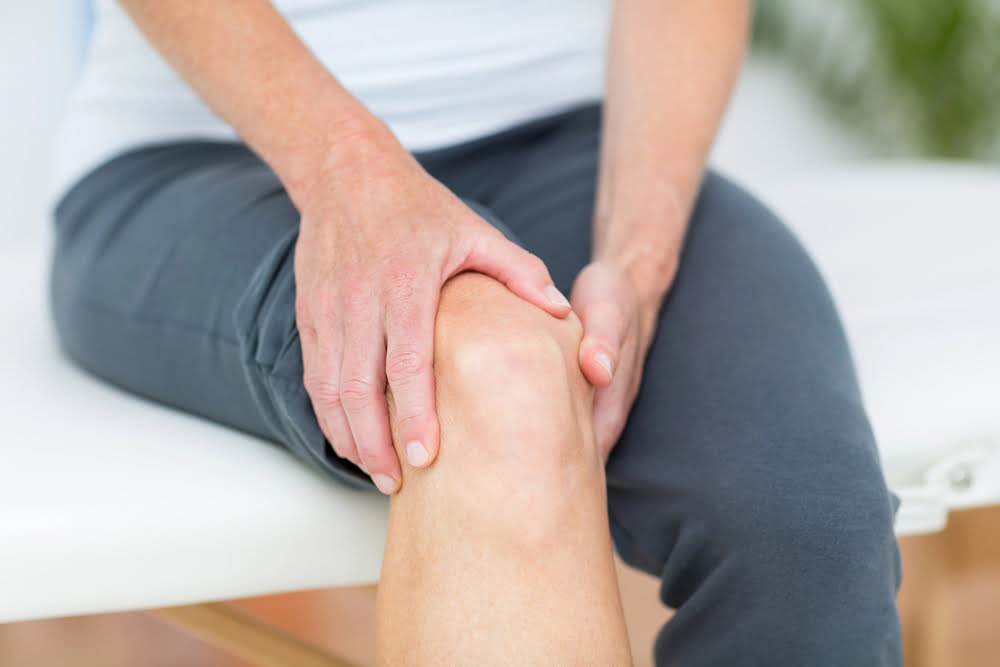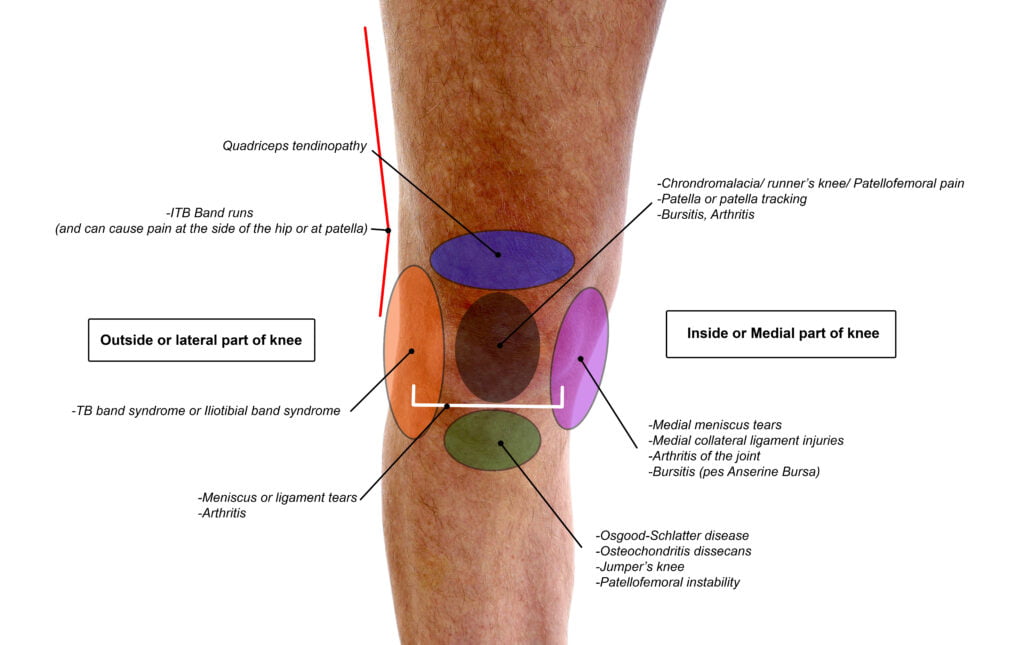Knee Pain: Causes & Treatment
Knees are complex. They can bend and straighten. However, other accessory movements that really shouldn’t occur can cause your knees harm when used repeatedly. Examples include, when squatting and the knee goes past the toes, the knee(s) fall inward, ( ie. “knock knees”), as well as,and planting the foot and turning the body or “twisting the knee” ( worse yet with cleats on). Our knees are being used constantly, and they are a joint that bears our body weight. Athletes are prone to injuring them when playing sports or exercising. Osteoarthritis and other conditions can affect people even if they haven’t put undue stress on their knees. Ie. They have a genetic predisposition to developing osteoarthritis in their knees.

The complexity of the knee joint makes it prone to injury and other painful conditions. Determining what conditions are affecting your knee can be difficult; we’ve created this guide to some of the most common knee conditions to help you learn more about what might be causing your knee pain:
Knee Pain Location Chart
Pay attention to where your knee pain is located and use this chart to get a better idea of what may be causing your knee pain. Then, read this article to find out more about the conditions that affect each area of the knee.

Pain Above the Knee
- Quadriceps tendonitis: ( also known as Patellar tendonitis) Your patellar tendon attaches your quadriceps to your knee cap ( patella) and shin bone ( tibia).This tendon can become inflamed, especially by repetitive movements like jumping or kneeling. Athletes are often affected by patellar tendonitis, which can usually be treated with Physiotherapy and Athletic therapy.
- Knee bursitis: Bursa are fluid-filled sacs that reduce pressure and friction between tissues and/or bones in our body. Knee bursitis typically happens with prolonged kneeling or overuse of the quadriceps muscle that puts extra pressure and tightness through the bursa. The condition can usually be treated with Physiotherapy, Athletic Therapy and medication ( typically anti-inflammatories).
Pain under, or around the Kneecap
- Patellofemoral femoral syndrome ( PFS ) : This condition causes pain behind and in surrounding areas of your kneecap. It can have several different causes and has been linked with overuse, injury, muscle imbalance, and weakness. It responds well to Physiotherapy, and Athletic Therapy. Often a patellofemoral sleeve /brace is helpful to keep the kneecap in line while therapy is taking place. Strengthening focuses on patellar tracking to eliminate unnecessary stressors on the knee.
- Chondromalacia patella: Commonly known as runner’s knee, this condition occurs when the cartilage on the underside of your kneecap breaks down. Physiotherapy, Athletic Therapy are often very helpful to treat the condition. If the wear under the kneecap is moderate to severe usually meds like anti-inflammatories can be very helpful.
- Knee Osteoarthritis: Osteoarthritis is when the cartilage wears away in a joint. The cartilage allows for shock absorption in the knee .There are a variety of non-surgical treatments for osteoarthritis, ranging from Physiotherapy to the use of nonsteroidal anti-inflammatory medications (NSAIDs).
Pain Located in the Inner Knee
- Medial plica syndrome: The plica is a band of fibrous tissue that protects your knee joint. The plica can become irritated due to injury through trauma or overuse. Rest, NSAIDs, steroid injections, stretches, and strengthening exercises can all help restore the plica.
- Medial collateral ligament (MCL) injury: MCL injuries and tears are common knee injuries. The MCL connects your thigh bone to your shin bone and provides strength and stability to the knee joint. MCL injuries can be caused by landing awkwardly, sports injuries, or repeated pressure and stress. Most of the time, rest, ice, compression, elevation, pain relievers, knee braces, and physical therapy will be enough to treat MCL injuries. Sometimes surgery may be required if the grade of tear is more severe and the joint is unstable.
- Medial meniscus tear: The medial meniscus is a cushion of thick cartilage located between the shinbone and thighbone, on the inside of the knee. Injuries to the meniscus often occur suddenly as a result of twisting your leg at the wrong time. These tears can lead to sudden, severe leg pain, and may be associated with other problems, like anterior cruciate ligament (ACL) injuries. Physiothrpay and Athletic Therapy is very helpful for meniscal rehab.These tears may be treated through rest, compression, stretching and strengthening exercises. If the tears are severe you may require surgery. The severity of the damage will be determined on an MRI.
Pain Located in the Outer Knee
- Iliotibial band (ITB) syndrome: The iliotibial band is a thick tendon that runs from your hip bones to the top of your shinbone. At times, the tendon may become too tight, which can cause irritation. This commonly occurs in athletes and is treated with rest, pain medications, physical therapy, and manual therapy.
- Lateral meniscus tear: The lateral meniscus is a cushion of thick cartilage located between the shinbone and thighbone, on the inside of the knee. Injuries to the meniscus often occur suddenly as a result of twisting your leg at the wrong time and can lead to sudden, severe leg pain. It can be treated through rest, compression, stretching and strengthening exercises, and other techniques. Minor lateral ( inside outer part of the knee) tears respond very well to Physiotherapy and Athletic therapy. Rest, ice, compression, elevation, and medications like NSAIDs. In some cases, surgery may be required.
- Lateral collateral ligament (LCL) injury: LCL tears occur on the ligament that connects your femur and fibula. As with other ligament tears, LCL injuries usually occur when playing sports like football and soccer. Minor LCL tears can usually be treated with physical therapy, rest, ice, compression, elevation, and medications like NSAIDs. In some cases, surgery may be required.
Pain Located in the Middle of the Knee
- Anterior cruciate ligament (ACL) injuries: The ACL is located in the middle of the knee; it prevents the shin bone from sliding in front of the thigh bone. Overextension and traumatic impact can cause ACL injuries and can be sudden, painful, and cause instability. Treatment typically involves rest and rehabilitation with a physiotherapist, but occasionally, surgery may be required.
Pain Below the Knee
- Sinding-Larsen-Johansson syndrome (SLJ): This syndrome affects children, generally between the ages of 10-14; it’s an injury to the growth plate where the kneecap attaches to the patellar tendon. As an overuse injury, it can be treated through rest, medication, and avoiding exercises and sports that could aggravate the knee.
- Patellar tendonitis: Commonly known as jumper’s knee, this condition is the inflammation of the tendon that connects your kneecap to your shinbone. Medications and physical therapy can both help reduce the symptoms of tendonitis.
- Osgood-Schlatter disease: This condition affects children, generally between the age of 10-15; it’s caused by irritation to the growth plate where the patellar tendon meets the shinbone. The condition can generally be treated with time and rest, though kneepads and tendon straps may also help.
- Fat pad impingement: Also known as Hoffa’s syndrome, this symptom occurs when the fat pad located below your kneecap and behind your patellar tendon becomes pinched (impinged). Manual therapy, orthotics, strength exercises, and more can help with this condition.
Pain Behind the Knee
- Chondromalacia patella: This condition can also be felt behind the knee.
- Baker’s cyst: Baker’s cysts occur when the knee is producing too much fluid/sweling; this can occur when arthritis or cartilage tears are present in the knee. The cyst can cause swelling and stiffness and the best way to treat the cyst is to treat the underlying condition, though NSAIDs can help reduce the swelling.
- Patellar tendonitis: This condition can also cause pain behind the knee.
Pain That Can Occur Anywhere in the Knee
- Knee contusions: Knee contusions are bruises; they can occur in the soft tissue or in the bone. They’re fairly easy to treat: Rest, ice, compression, and elevation (RICE) are typically all that is needed. For severe bone bruises, a brace may help speed up recovery.
- Arthritis: There are several different types of arthritis that can affect the knee, including rheumatoid arthritis, osteoarthritis, and gout. The pain from arthritis can affect your entire knee but physical therapy, medications, and other treatments can help alleviate arthritis pain.



